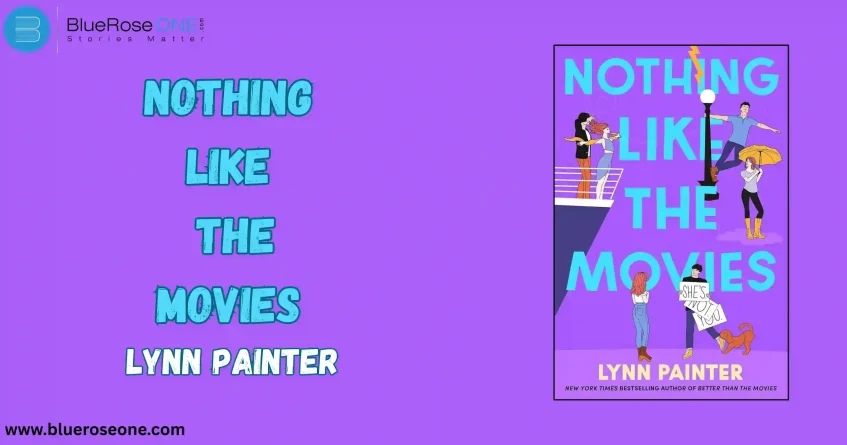1. Opening Conversation
You know that moment when you pick up a book maybe on a lazy afternoon, or during a restless midnight and it doesn’t feel like a story you’re reading, but one you’re gradually living? That’s how Nothing Like the Movies took hold of me.
It wasn’t just the title it was the feeling: a gentle invitation that whispered, This might sound familiar. This might feel like you. I approached it with no expectations beyond escape, and by the end, it felt like I’d closed the front cover and was greeted by an old friend, all warmth and shared secrets.
I’m writing this global love letter to Painter’s book not with academic detachment, but as though I’m settling into a cozy circle of friends sharing why her words stayed with me and why I think they’ll stay with you, too.
You may alos like: Bunny vs Monkey Books in Order – Ultimate Reading Guide
2. Gentle, Spoiler-Conscious Overview
Let us gently into the story without spoiling the journey. At its core, Nothing Like the Movies is a character-driven story about a woman balancing love, ambition, scepticism, and the echo of her own ambitions.
Without revealing specific story points, because the beauty is in the gradual, poignant revelations, suffice it to say: Painter frames her canvas with human instinct.
We encounter someone at a crossroads, someone who recognises that life isn’t a screenplay with flawless arcs or predictable conclusions, but nevertheless seeks purpose, connection, and, perhaps, salvation in the tiny moments.
The narrative doesn’t roar it hums. It pulses quietly, surprisingly. We’re invited into internal landscapes, small gestures, stolen glances. There’s that relatable intimacy: the way rejection can sting, the flicker of knowing someone sees your scars, the tenuous thrill of dreaming bigger than the life you’ve settled for.
Painter’s promise is not to entertain with plot fireworks, but to illuminate the tender ache of existing in search of more more love, more clarity, more a sense of being enough. I found myself turning pages because I cared, deeply, for each breath her characters took.
3. What Truly Shined
If I’m honest about what made my heart beat a little louder, it’s the characters complex, flawed, achingly human. Painter doesn’t invent people; she listens to them.
The protagonist feels like someone you once knew or maybe someone you’re still trying to understand about yourself.
There’s an unpolished authenticity in each dialogue exchange, in the silences between words. These aren’t characters with bold proclamations or towering arcs; they’re present, muddling through, bracing against their own missteps while reaching for something gentler.
Painter’s emotional honesty is the book’s beating heart. Where some writers might shy away from awkward truths, or romantic tension overstated, Painter holds still within discomfort. A confession doesn’t burst through dramatic thunder it lands softly, like rain against glass. The effect: you feel it more.
And the pacing oh, the pacing feels almost cinematic. It’s measured, with emotional timing that recalls a film whose rhythm you absorb less consciously and more through bodily cadence.
You don’t notice it until a shift arrives, seamless, and suddenly you’re leaning closer. The structure is subtle, interspersing quiet reflection with moments that spark with enough tension to make breaths hitch not loud or jolting, but effective.
You may also read: Lottie Brooks Books in Order: A Quick & Fun Guide
4. My Personal Takeaways & Emotional Echoes
There were lines that shimmered long after I closed the book. Not because they were flashy or quotable in isolation, but because they threaded quietly into something in me like the recollection of a childhood promise or an ache you couldn’t name.
I noticed how Painter describes someone’s breath, or a moment shared over coffee, or the little regrets that stay hidden until they’re acknowledged and suddenly they become achingly, tenderly alive.
One image lingered: a protagonist pausing at a window, watching someone walk away in the reflection of streetlights. The moment alone presses both nostalgia and the quiet ache of longing into your chest. I carried it with me not as a quote, but as an emotional residue that echoed in my own quieter moments.
Themes of aspiration versus acceptance dance throughout. We root for characters to break free, to pursue something more, while also understanding the weight of fear, routine, and history. It reminded me of the tug-of-war I’m always in wanting more, yet longing for stillness. That tension felt like a shared glance across time, a universal echo in the mind and heart.
Re-reading certain scenes felt different. The first time, I was carried. The second, I traced nuance: how dialogue cadence shifts when two people are close but not yet joined. It’s the kind of book that doesn’t preach; it invites reflection. I found myself in the unspoken spaces.
You may also read: How to Read Jack Carr Books in Order: Ultimate Guide
5. Thoughtful Critique—What Didn’t Fully Land for Me
If I look critically, there were moments where familiarity lingered scenes or emotional beats that felt like echoes from broader contemporary literary fiction, where the aching heroine wakes up jazzed about chance encounters or coffee shop dialogues.
There’s a delicate balance between resonance and cliché, and a few times I wavered on the edge. Moments where inner monologues tread close to tropes: the “I’m not enough” lament, or the daydreamer’s escape-mongering.
But even in those familiar notes, Painter’s voice redeemed them. The sincerity her refusal to dramatize kept it grounded. If anything, tightening a couple of those scenes to sharpen the emotional stakes or hint at specificity in setting would’ve been icing. But modest revision wouldn’t erase the enduring heart of the narrative.
It’s not a blockbuster story, and some readers might crave more narrative drive. Painter chooses intimacy over action, character arcs over plot arcs. That may not land for someone seeking momentum over mood. And that’s not a flaw it’s a deliberate choice. Just something worth knowing going in.
6. Voice, Style & Cinematic Flair
Painter’s writing really leans into its cinematic leanings there’s a perceptiveness to her words, an eye for interior lighting. A thought is framed like a shot: low light in the corner of memory, distant car headlights framing a reflective inner monologue, the smoky blur of a café corner. Her prose doesn’t dictate what you see; it suggests, lets your imagination fill in the lenses.
Her voice feels direct mostly stripped of ornamental language but with sudden bursts of lyricism. Like someone telling you about a day when a moment felt suspended, like glass, and your chest hollowed with belonging or loss. That moment might be a few lines of ordinary description and still cut through with unspoken ache.
There’s also an almost filmic editing sense. Scenes transition with emotional transitions, not chapter breaks. A sigh in one paragraph resonates in the next scene’s street hum. She layers memory and current scene gently like soft crossfades. As a reader, you don’t notice the technique until you’re enveloped.
You may also like: List of Richard Osman Books in Order: Complete Reading Guide
7. Why This Matters Now—Relevance & Resonance
In a world spinning faster every day, Nothing Like the Movies slows things. It doesn’t offer a crash course in coping with global anxieties; it offers the quieter possibility of connection, of being seen in your half-formed longings. There’s something radical about that not rallying against injustice (though there are emotional stakes), but in whispering: “Your interior life matters. Your emotion matters.”
Especially now, when our screens are clogged with perfection Instagram smiles, viral panics, cinematic tragedy it’s a balm to see a book that offers flawed people who don’t have meteoric arcs or redemptive fireworks. They’re not perfect. But they’re real. They’re human. And in her devotion to human nuance, Painter writes something quietly revolutionary.
In literary company, this book might sit next to those lean, emotionally attuned novels that cherish the unscripted where the quiet pulse of realism counts more than sweeping arcs. Yet Painter’s cinematic framing, without the spectacle, gives it a certain luminous solitude. In short: it matters because it remembers what feels true.
8. Closing Chat—Final Thoughts & Recommendation
So here I am, closing my laptop with a smile. I’ve told you why Nothing Like the Movies moved me: its tender realism, emotional intimacy, careful pacing the way it felt like language listening. It’s not a sky-splitting roar of a novel, but one that pulses with small truths, with longing held in stillness.
If you’re craving a book that feels like a quiet conversation in dim light like someone leaning in to say, “I know,” this might be the one. Maybe you’ll carry it like I carried it, long after the pages fade. Maybe you’ll find yourself in the unspoken spaces, relating to the ache, the hope, the way we try to taste life more fully, even in stillness.
That’s my invitation. Let the world’s noise quiet for a while. Let this novel lean in close. Sometimes that’s where the real story lives.
You may also read: Dog Man Books in Order: Books Listed Chronologically

3.9/5 Stars
Title: Nothing Like the Movies
Author: Lynn Painter
Genre: Romance
Age Range: Young Adult
Publisher: Simon & Schuster
Release Date: Out Now!
















